Mistakes Everyone Makes When Cooking Peas
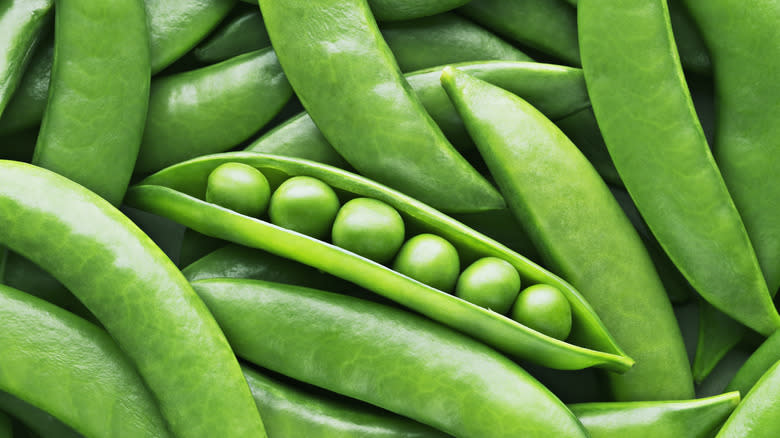
Peas are usually the least of your worries when it comes to making a meal. They are so easy to prepare that they are often the go-to choice for a quick side dish when you're running short on time and ingredients. Just pour some into a pot, boil them for a handful of minutes, and garnish them with salt, pepper, and a little butter. What could be easier? They are also full of health benefits. Per the USDA, just one cup of peas contains 8 grams of protein, 8 grams of fiber, and 8 grams of sugar, making them a flavorful, energy-rich, and protein-dense option available for a wide range of dietary needs.
Considering how nutritious, easy, and readily available these veggies are, it's no wonder that Americans spend more than $60 million on frozen peas annually. They crop up in recipes for everything from pasta to paella and taste just as good on their own. But with so many ways to use them, it's also no surprise that they are often cooked incorrectly or without much consideration. While this rarely renders them inedible, it also prevents them from showing off their potential. With this in mind, we've rounded up the mistakes we all make when cooking with peas to ensure that we allow them to shine in all their glory.
Read more: 12 Little-Known Facts About Salt
Overcooking Them
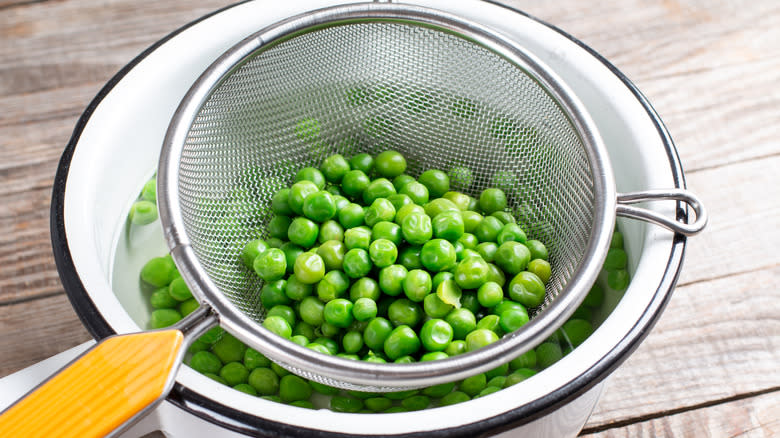
Peas are fairly indestructible compared with other vegetables. You don't notice a mushy pea with as much irritation as you might notice a mealy piece of broccoli or disintegrating potatoes, and because of this, it's easy to neglect them and accidentally boil them for 15 minutes or more while you work on a fussier part of the meal. You might even remember to take them off the heat in time but wait to drain them until you're ready to serve them. This doesn't pose a health risk or completely ruin their flavor, but it can turn perfectly good peas into an uninspiring, incidental part of the meal instead of the ingredient that brings everything together.
Overcooking is particularly common with frozen peas because many people think they have to cook them longer than necessary. Most frozen peas are flash-steamed before being packaged, which means that all you have to do is heat them enough to kill off potential pathogens, not fully cook them a second time. We're talking one or two minutes, not 10 or 15. The longer you leave them in the water, the mushier they will become and the less sweet they will taste.
Not Heating Frozen Peas Enough
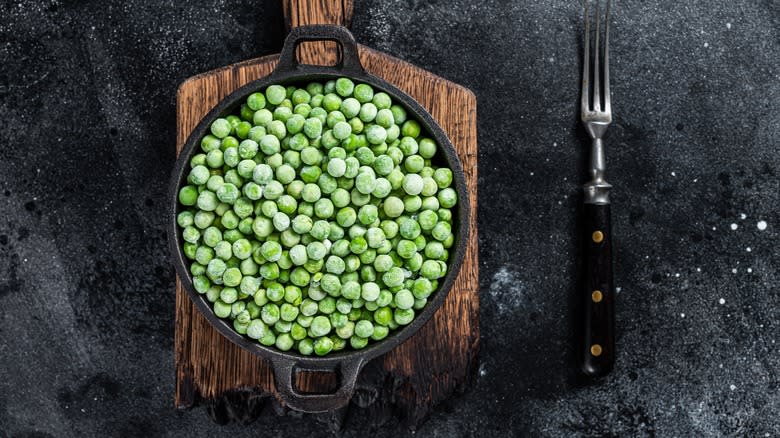
Just when you thought peas were as uncomplicated as veggies come, we're here to spoil it for you: frozen peas can not only be overcooked, but undercooked as well. In fact, undercooking them is worse than overcooking them because it could pose a danger to your health. According to the FDA's Food Code, manufacturers are not obliged to adhere to certain protocols to control pathogens as long as they provide their customers with cooking directions. If your package of frozen peas has cooking instructions on it, it's not just a helpful suggestion; it's a food safety warning. Heating the peas as directed by the packaging should kill off any harmful microorganisms. Restaurants are required to follow these instructions, and home cooks should too.
Although the chance of contracting an illness from bacteria that might be lurking on frozen peas is small, it isn't zero. Recalls on frozen veggies do occur from time to time, and considering it only takes 90 seconds to boil them, it's well worth doing.
Not Rinsing Canned Peas
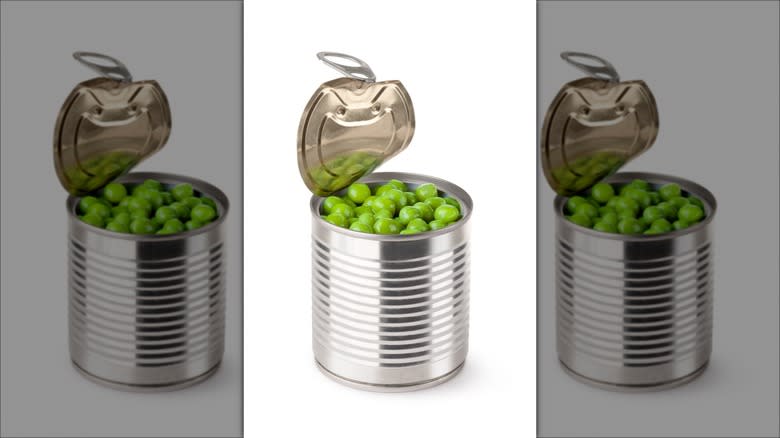
Canned peas offer the ultimate convenience. Unlike frozen peas, they don't need to be thawed before being added to your meal. You can simply dump them into your soup or chicken pot pie filling and carry on with the recipe. But doing so is a nutritional error, because unless labeled otherwise, canned peas are loaded with salt.
Although it is an essential part of our diet that helps balance water levels in the body and facilitates nerve functioning and muscle contraction, sodium is unhealthy in high amounts (via the Harvard School of Public Health). The FDA recommends consuming no more than 2300 milligrams of it per day, which is far lower than the 3400 milligrams that we consume on average. Too much sodium can cause high blood pressure, which in turn can cause strokes and heart disease.
Without realizing it, you're pouring a significant portion of your recommended daily intake of sodium into your food when you add canned peas. A half cup of Walmart's Great Value canned peas, for example, contains 15% of the recommended daily value of salt — it's 52% of the DV if you eat the whole can. Luckily, you don't have to cut canned peas out of your diet or search for those that are labeled low sodium. All you have to do is rinse them.
Adding Them Too Early In A Recipe
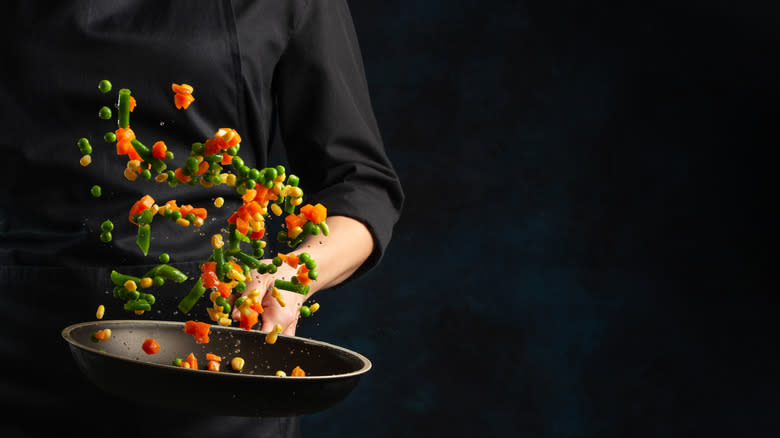
Cooking is all about timing. Leave a poached egg simmering too long and the all-important runny yolk will become solid. Mix wet ingredients with dry ingredients at the beginning of a cake recipe and you'll end up with something rubbery and dense rather than light and airy. You might not think that peas would be another ingredient that relies on perfect timing, but they do, at least if you want them to be as eye-catching and flavorful as possible.
Chlorophyll, the compound that gives peas their trademark lime green color, begins to degrade when exposed to heat, turning the peas an unappetizing, murky green-brown hue. Prolonged cooking, such as when you add them to soup at the beginning of the recipe, also makes them lose their sweetness, undermining their main function in savory dishes. Added to these pitfalls is a loss of texture. If you let peas simmer in a soup while you wait for the other veggies to soften, they will lose their shape and may even start to disintegrate. To avoid these unappetizing outcomes, it's best to add peas toward the end of your cooking process. If you're making soup, simply add them a minute or two before you take the pot off the stove. That gives them plenty of time to cook but avoids the deterioration of color, flavor, and texture that happens all too quickly.
Ignoring The Pod
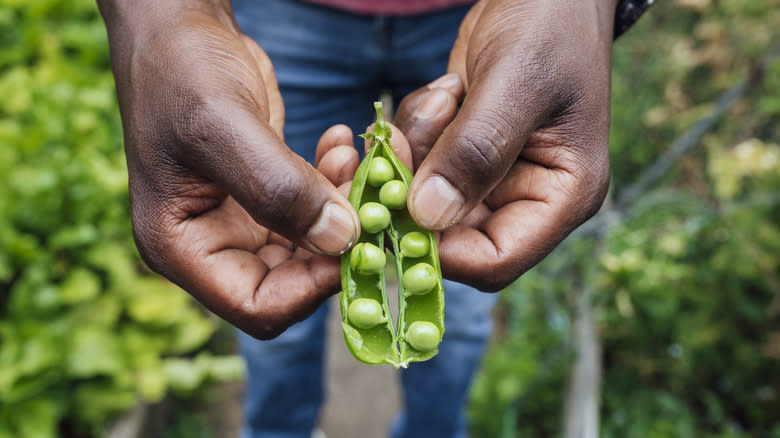
Most of us use frozen or canned peas when cooking, but during the summer, fresh peas are in season, and there is nothing that compares to their freshness and sweetness. The sooner you eat the peas after they are harvested, the sweeter they will be. You can even eat them raw. If you're used to cooking with fresh peas, you probably dread shelling them. This process of breaking open the pods and removing the peas is meditative at best and agonizingly time-consuming at worst. It might even deter you from buying fresh peas at all. But this would be a loss, because some of the most flavorful and tender varieties can be conveniently eaten in their pods.
The peas that you find canned and frozen are usually garden peas (also called green peas and English peas), which have inedible pods. Snow peas and sugar snap peas, on the other hand, can be eaten whole, no shelling necessary. This is obvious with snow peas, as the peas themselves are so tiny that you couldn't remove them individually if you tried, but sugar snap peas are full-sized and look very similar to garden peas. Pea pods are actually a type of fruit since they contain seeds, and, like other fruits, happen to be full of natural sugar and flavor. You can eat them raw or cooked, but if you choose the latter, make sure to cook them for only a few minutes to maintain their sweetness and crunchiness.
Boiling Them
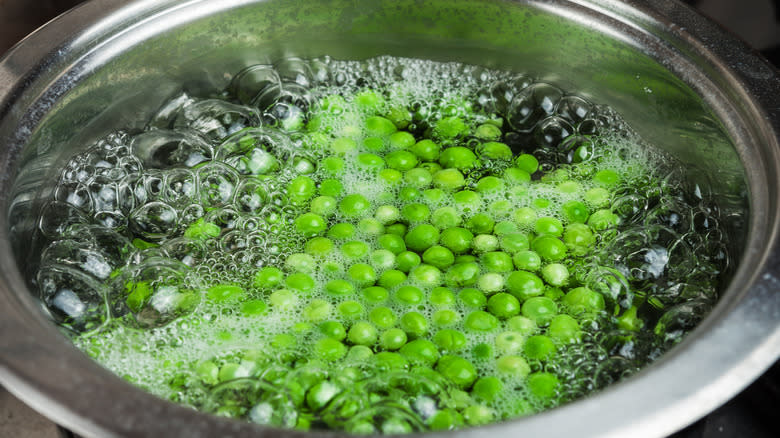
Boiling peas, especially frozen ones, is almost second nature for many cooks. It's quick, easy, and hands-off, and for those who don't own a microwave, it might seem like the only option. But despite the convenience, boiling peas isn't doing you any favors. If left in the water for too long, boiled peas become mushy, soggy, colorless, and tasteless. For a vegetable that already has a delicate texture and subtle flavor, this process can turn it into a culinary non-entity. Even worse, however, boiling peas leaches them of nutrients.
In a study in the journal Food Science and Biotechnology that tested the effects of different methods of cooking on various types of vegetables, researchers found that boiling caused the greatest loss of vitamin C, while microwaving caused the least. In general, water-soluble nutrients like vitamin C, thiamin, riboflavin, niacin, and B vitamins are lost during boiling, while minerals including potassium, calcium, and iron can dwindle by 70% (via Sutter Health). To avoid nutrient loss, microwaving and steaming are the best options. To retain flavor and texture, however, sauteing peas in a saucepan is preferable. The high temperature will cause some nutrient loss, but without water for the nutrients to leach into, there will still be plenty left over. By sauteing the peas, you prevent them from becoming soggy and allow them to maintain their firm texture.
Overlooking Them As A Main Ingredient
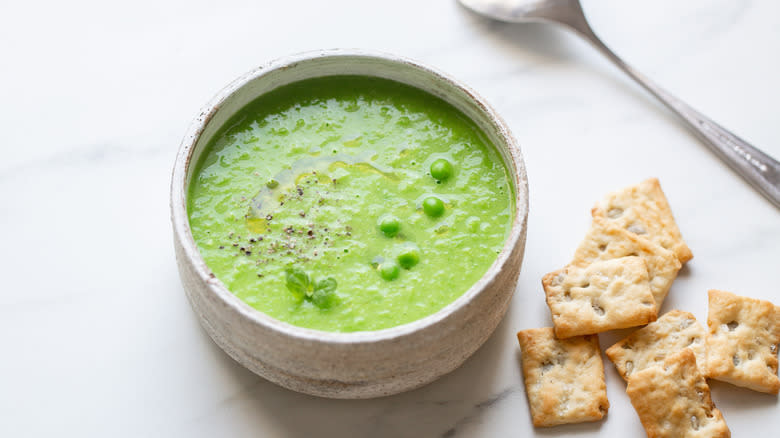
We all know that peas can jazz up a lackluster stir-fry and play a pivotal role in cottage pie, but their ability to elevate other ingredients can make it easy to forget that they are a killer main ingredient in their own right. If you've never crafted a meal based around peas, you'll be amazed at the variety and quality of dishes that you can make with them. Of course, they are already a known quantity for side dishes. Fish and chips wouldn't be the iconic meal that it is without a side of mushy peas, and you can brighten up even the drabbest of dinners by whipping up some flash-fried snow peas. As a member of the pulse family alongside chickpeas, beans, and lentils, peas can also be turned into a delicious and substantive alternative to hummus. With their sweet, vegetal taste and creaminess when blended, they will make you forget about chickpea-based dips altogether.
As for main dishes, peas can be turned into the focal point of summer picnics and cold winter evenings alike. For an outdoor barbecue, you can make a summer pea salad with peas, chopped veggies, and a citrusy dressing that will take the edge off the oppressive seasonal heat. In winter, you can warm yourself up with split pea soup, a comforting, nutrient-rich meal that makes a great alternative to lentil soup.
Discarding The Cooking Liquid
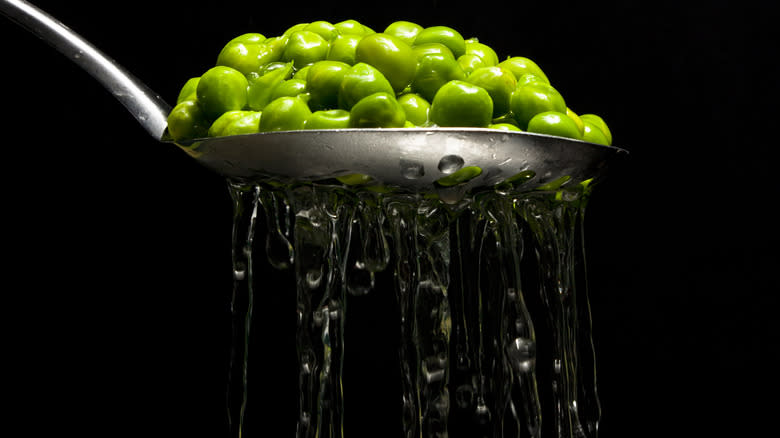
If you do decide to boil peas, make sure you don't toss out the liquid when you drain them. That murky yellow-green water is, believe it or not, a celebrated ingredient in some circles, and even if you've never heard of the word "potlikker," you can benefit from it. When nutrients seep out of vegetables during the boiling process, they don't just disappear. They go straight into the boiling water. Once you've drained the vegetables, a hefty proportion of their nutritional value goes right down the drain. That leftover water is called potlikker, and it has been used in everything from boiled peanuts to martinis. Like miso and fish sauce, it provides a surprising hint of pungent earthiness that can liven up a dish, albeit in small quantities.
Even if you aren't up for culinary innovation though, there are plenty of unadventurous ways to put it to good use. For example, adding it to gravy in place of water can give your recipe a nutritional boost and a subtly complex flavor. Any savory recipe that calls for water can use leftover vegetable cooking liquid instead, whether you're boiling rice or diluting a stew. It can even be the secret to healthy, leafy houseplants. Just let it cool to room temperature and add it to your watering can.
Not Exploring Different Varieties
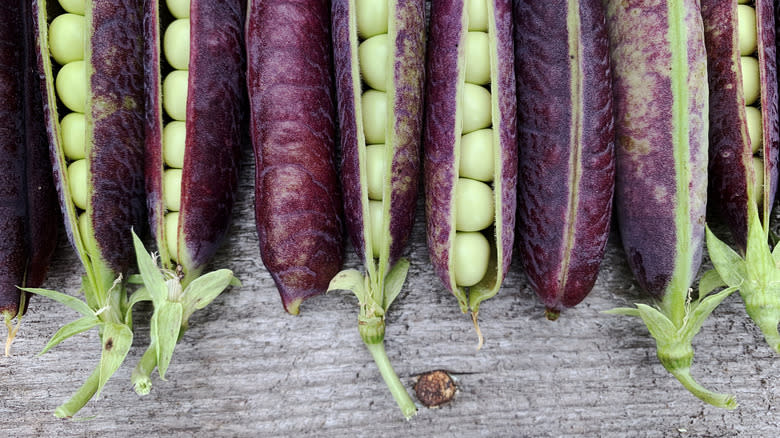
The stereotypical pea is green, sweet, and sitting in a bag in your freezer, but there are many other varieties that are equally delicious and versatile. There are the ones with edible pods, including the juicy sugar snap pea and the delicate snow pea, which is often found in Asian cuisine. Then there are the visually striking varieties, such as the purple podded pea, which sports a striking purple-hued pod encasing lime green peas, and the big red ripper Southern pea that looks like a long, red string bean. Each of these provides a unique flavor, with the sugar snap peas being so sweet that you could eat them for dessert.
Another pea variety that is often overlooked is the split pea, a type of field pea that is dried and split in half soon after harvesting. Like lentils, they do not need to be soaked before cooking the way other legumes such as kidney beans and chickpeas do. Split peas can either be yellow or green and are the foundational ingredient in hearty soups and plant-based winter stews. They are also the base ingredient in many pea-based products such as pea milk and pea protein due to their high protein content.
Ignoring The Rest Of The Plant
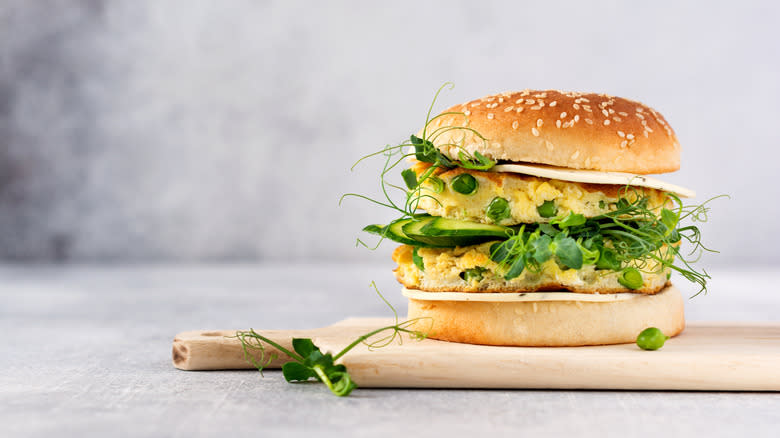
Pea plants are more than the tender green morsels you buy in the frozen section of the grocery store. Aside from their pods, which, depending on the variety of pea, are either inedible or a delicious ingredient in their own right, are shoots, leaves, and flowers. Peas are climbing vines and the shoots are the delicate tendrils that coil themselves around whatever structure is nearby. For culinary purposes, the tendrils are harvested early, when they still resemble microgreens. Their leaves are small and their flavor is sweet, delicate, and grassy. The sooner you eat them, the sweeter they will be. Because of this short shelf life, however, they can be hard to find except at farmer's markets and specialty grocers. If they're very young shoots, they're best served raw to maintain their bright, fresh flavor and crunch. If they're slightly more mature, however, they can have a tough texture that requires sauteeing.
Pea leaves are exactly what they sound like: the leaves of the pea plant. Unlike pea tendrils, they are harvested later in the season when they are larger and the tendrils are too fibrous to eat. Like shoots, they have a sweet, fresh flavor, and make a delicious and nutrient-packed alternative to other types of greens in stir-fries.
Not Using The Flowers
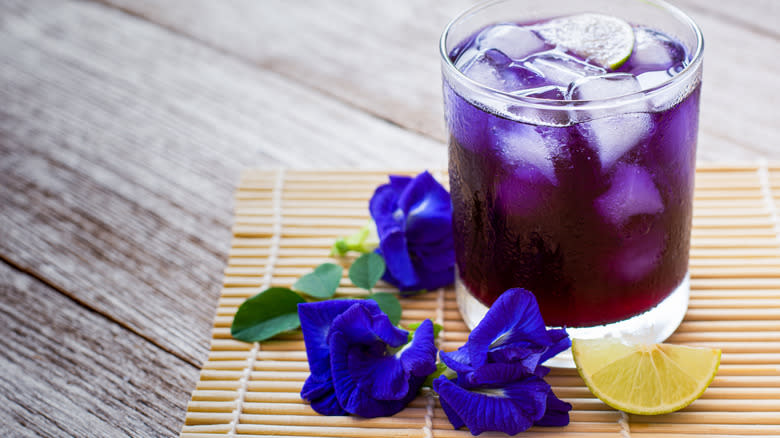
Not all flowers are edible. You might end up severely ill if you were to grab a daffodil from the bouquet on your kitchen table and toss it into your Caesar salad or garnish a sandwich with it. But there are many varieties that can make delicious and visually striking additions to your meal. Pea flowers from specific pea varieties are one such option. It's crucial to note that not all pea varieties yield edible blossoms. Garden peas (Pisum sativum), which include English peas and snow peas, produce edible blossoms, but sweet peas (Lathyrus odoratus) are poisonous. If you're buying pea blossoms from the grocery store as edible flowers, you can assume that they're safe to eat, but if you plan to harvest them from your garden, double-check which variety you have.
With that caveat aside, there are many reasons why you might want to incorporate pea flowers into your cooking. Snow pea flowers are either white or light purple and can be served as a garnish for salads or any dish that you want to give a pop of ethereal elegance. They are lightly sweet, like peas, and have a delicate texture.
Butterfly peas are even more striking and are a rarity in that they are used primarily for their blossoms rather than their seeds. They turn foods a vibrant shade of dark blue-purple and have been used to color everything from lattes and cocktails to cupcakes and stir-fries.
Only Using Them In Savory Recipes
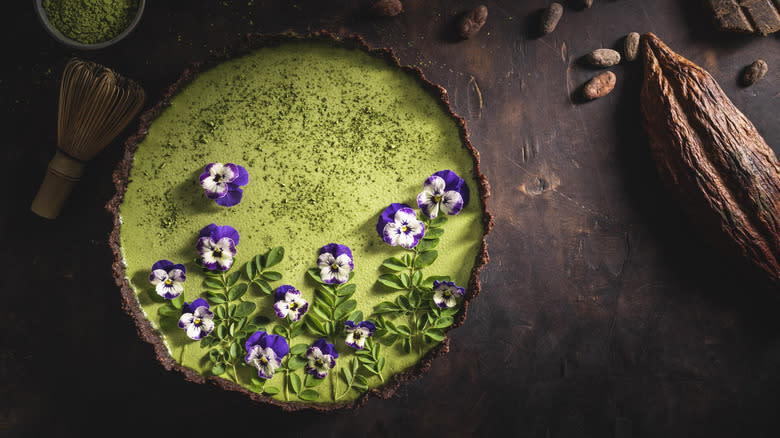
Peas are used in a wide range of recipes, and they're a go-to wildcard ingredient when you want to add a little flavor to a bland soup or need a quick side dish. But no matter how liberally you're using peas in your cooking, you probably aren't using them to their full potential. Believe it or not, they can be a secret weapon in desserts.
It's not as far-fetched as it might seem. After all, people don't bat an eye at adding other vegetables to sweet recipes. Carrot cake, zucchini bread, and pumpkin pie are all veggie-based desserts that even un-adventurous eaters can get behind. You could even argue that peas belong in sweet recipes even more than these other veggies. 100 grams of them contain almost 6 grams of sugar, which is more than the 2.5 grams in zucchini, and even more than the 5 grams in carrots. Peas can be pureed and added to almost any dessert recipe to produce a mild, sweet flavor and bright color and are especially useful when you want a pistachio recipe to be green without turning to artificial food dyes.
Read the original article on Mashed.

